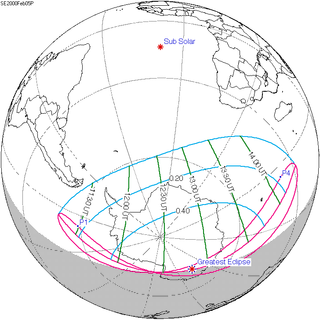Solar eclipse of February 5, 2000
| Solar eclipse of February 5, 2000 | |
|---|---|
| Type of eclipse | |
| Nature | Partial |
| Gamma | −1.2233 |
| Magnitude | 0.5795 |
| Maximum eclipse | |
| Coordinates | 70°12′S 134°06′E / 70.2°S 134.1°E |
| Times (UTC) | |
| Greatest eclipse | 12:50:27 |
| References | |
| Saros | 150 (16 of 71) |
| Catalog # (SE5000) | 9507 |
A partial solar eclipse occurred on February 5, 2000. A solar eclipse occurs when the Moon passes between Earth and the Sun, thereby totally or partly obscuring the image of the Sun for a viewer on Earth. A partial solar eclipse occurs in the polar regions of the Earth when the center of the Moon's shadow misses the Earth. It was only visible over Antarctica.
Images[edit]
Related eclipses[edit]
Eclipses of 2000[edit]
- A total lunar eclipse on January 21.
- A partial solar eclipse on February 5.
- A partial solar eclipse on July 1.
- A total lunar eclipse on July 16.
- A partial solar eclipse on July 31.
- A partial solar eclipse on December 25.
Solar eclipses 1997–2000[edit]
This eclipse is a member of a semester series. An eclipse in a semester series of solar eclipses repeats approximately every 177 days and 4 hours (a semester) at alternating nodes of the Moon's orbit.[1]
| Descending node | Ascending node | |||||
|---|---|---|---|---|---|---|
| Saros | Map | Gamma | Saros | Map | Gamma | |
120 Chita, Russia |
1997 March 09 Total |
0.91830 | 125 | 1997 September 02 Partial (south) |
−1.03521 | |
130 Total eclipse near Guadeloupe |
1998 February 26 Total |
0.23909 | 135 | 1998 August 22 Annular |
−0.26441 | |
| 140 | 1999 February 16 Annular |
−0.47260 | 145 Totality from France |
1999 August 11 Total |
0.50623 | |
| 150 | 2000 February 05 Partial (south) |
−1.22325 | 155 | 2000 July 31 Partial (north) |
1.21664 | |
Partial solar eclipses on July 1, 2000 and December 25, 2000 occur in the next lunar year eclipse set.
Saros 150[edit]
It is a part of Saros cycle 150, repeating every 18 years, 11 days, containing 71 events. The series started with partial solar eclipse on August 24, 1729. It contains annular eclipses from April 22, 2126 through June 22, 2829. There are no total eclipses in this series. The series ends at member 71 as a partial eclipse on September 29, 2991. The longest duration of annularity will be 9 minutes, 58 seconds on December 19, 2522.
| Series members 11-21 occur between 1901 and 2100: | ||
|---|---|---|
| 11 | 12 | 13 |
 December 12, 1909 |
 December 24, 1927 |
 January 3, 1946 |
| 14 | 15 | 16 |
 January 14, 1964 |
 January 25, 1982 |
 February 5, 2000 |
| 17 | 18 | 19 |
 February 15, 2018 |
 February 27, 2036 |
 March 9, 2054 |
| 20 | 21 | |
 March 19, 2072 |
 March 31, 2090 | |
Metonic series[edit]
The metonic series repeats eclipses every 19 years (6939.69 days), lasting about 5 cycles. Eclipses occur in nearly the same calendar date. In addition, the octon subseries repeats 1/5 of that or every 3.8 years (1387.94 days). All eclipses in this table occur at the Moon's descending node.
| 22 eclipse events between September 12, 1931 and July 1, 2011. | ||||
|---|---|---|---|---|
| September 11-12 | June 30-July 1 | April 17-19 | February 4-5 | November 22-23 |
| 114 | 116 | 118 | 120 | 122 |
 September 12, 1931 |
 June 30, 1935 |
 April 19, 1939 |
 February 4, 1943 |
 November 23, 1946 |
| 124 | 126 | 128 | 130 | 132 |
 September 12, 1950 |
 June 30, 1954 |
 April 19, 1958 |
 February 5, 1962 |
 November 23, 1965 |
| 134 | 136 | 138 | 140 | 142 |
 September 11, 1969 |
 June 30, 1973 |
 April 18, 1977 |
 February 4, 1981 |
 November 22, 1984 |
| 144 | 146 | 148 | 150 | 152 |
 September 11, 1988 |
 June 30, 1992 |
 April 17, 1996 |
 February 5, 2000 |
 November 23, 2003 |
| 154 | 156 | |||
 September 11, 2007 |
 July 1, 2011 | |||
References[edit]
- ^ van Gent, R.H. "Solar- and Lunar-Eclipse Predictions from Antiquity to the Present". A Catalogue of Eclipse Cycles. Utrecht University. Retrieved 6 October 2018.





